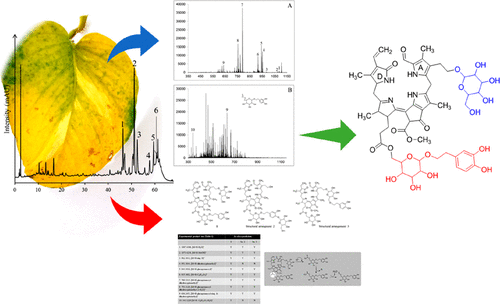当前位置:
X-MOL 学术
›
J. Nat. Prod.
›
论文详情
Our official English website, www.x-mol.net, welcomes your
feedback! (Note: you will need to create a separate account there.)
Profile of Chlorophyll Catabolites in Senescent Leaves of Epipremnun aureum Includes a Catabolite Esterified with Hydroxytyrosol 1-O-Glucoside.
Journal of Natural Products ( IF 3.3 ) Pub Date : 2020-03-05 , DOI: 10.1021/acs.jnatprod.9b00546 María Roca 1 , Antonio Pérez-Gálvez 1
Journal of Natural Products ( IF 3.3 ) Pub Date : 2020-03-05 , DOI: 10.1021/acs.jnatprod.9b00546 María Roca 1 , Antonio Pérez-Gálvez 1
Affiliation

|
Despite the fact that chlorophyll degradation is a physiological phenomenon occurring daily in all photosynthetic tissues, chlorophyll catabolites are not fully identified. Three new forms (1, 3, and 4) of linear chlorophyll catabolites (phyllobilins) have been characterized in senescent leaves of Epipremnun aureum with spectroscopic data. Compound 1 is a hypermodified blue fluorescent chlorophyll catabolite (hmFCC) esterified with the potent antioxidant hydroxytyrosol. The sequestration of this phenol by a chlorophyll catabolite could explain the physiological meaning of the persistence of hmFCCs in some senescent plants. Compound 3, a yellow chlorophyll catabolite (YCC) originated from the oxidation at C-15 of 1. YCCs have been identified previously and are exclusively formed in the plant vacuole from the final nonfluorescent chlorophyll catabolites (NCCs). The presence of 3 in leaves implies a new reaction in chlorophyll catabolism, as the characterization of 3 implies that YCCs can be also be oxidized in the cytosol from FCCs. Finally, phyllobilin 4 represents a new type of YCC characterized by an inflexible bicyclo glucosyl moiety linked through an intramolecular esterification of the propionic acid residue with the C-3 hydroxy group. The corresponding NCC precursor was recently identified and now the characterization of 4 shows that even this rigid structure can be further oxidized. Undoubtedly, the characterization of phyllobilins is essential to completely comprehend chlorophyll degradation.
中文翻译:

在表皮葡萄球菌的衰老叶片中的叶绿素分解代谢物的轮廓包括用羟基酪醇1-O-葡糖苷酯化的分解代谢物。
尽管叶绿素降解是每天在所有光合作用组织中发生的生理现象,但叶绿素分解代谢物尚未完全鉴定。利用光谱数据已在金黄色葡萄球菌的衰老叶片中表征了线性叶绿素分解代谢物(叶绿素)的三种新形式(1、3和4)。化合物1是用强效抗氧化剂羟基酪醇酯化的超改性蓝色荧光叶绿素分解代谢物(hmFCC)。叶绿素分解代谢物对这种酚的螯合可以解释某些衰老植物中hmFCC持续存在的生理意义。化合物3,一种黄色叶绿素分解代谢物(YCC),源自C-15处1的氧化。YCC以前已经被鉴定出来,并且仅在植物液泡中由最终的非荧光叶绿素分解代谢物(NCC)形成。叶片中3的存在暗示叶绿素分解代谢发生新反应,因为3的表征暗示YCC也可以在FCC的细胞质中被氧化。最后,叶绿素4代表一种新型的YCC,其特征是通过丙酸残基与C-3羟基的分子内酯化连接的不挠性双环葡萄糖基部分。最近鉴定出了相应的NCC前体,现在的特征4显示即使该刚性结构也可以被进一步氧化。毫无疑问,叶绿素的表征对于完全理解叶绿素的降解至关重要。叶片中3的存在暗示叶绿素分解代谢发生新反应,因为3的表征暗示YCC也可以在FCC的细胞质中被氧化。最后,叶绿素4代表一种新型的YCC,其特征是通过丙酸残基与C-3羟基的分子内酯化连接的不挠性双环葡萄糖基部分。最近鉴定出了相应的NCC前体,现在的特征4显示即使该刚性结构也可以被进一步氧化。毫无疑问,叶绿素的表征对于完全理解叶绿素的降解至关重要。叶片中3的存在暗示叶绿素分解代谢发生新反应,因为3的表征暗示YCC也可以在FCC的细胞质中被氧化。最后,叶绿素4代表一种新型的YCC,其特征是通过丙酸残基与C-3羟基的分子内酯化连接的不挠性双环葡萄糖基部分。最近鉴定出了相应的NCC前体,现在的特征4显示即使该刚性结构也可以被进一步氧化。毫无疑问,叶绿素的表征对于完全理解叶绿素的降解至关重要。叶绿素4代表一种新型的YCC,其特征是通过丙酸残基与C-3羟基的分子内酯化连接的不可挠曲的双环葡萄糖基部分。最近鉴定出了相应的NCC前体,现在的特征4显示即使该刚性结构也可以被进一步氧化。毫无疑问,叶绿素的表征对于完全理解叶绿素的降解至关重要。叶绿素4代表一种新型的YCC,其特征是通过丙酸残基与C-3羟基的分子内酯化连接的不可挠曲的双环葡萄糖基部分。最近鉴定出了相应的NCC前体,现在的特征4显示即使该刚性结构也可以被进一步氧化。毫无疑问,叶绿素的表征对于完全理解叶绿素的降解至关重要。
更新日期:2020-03-05
中文翻译:

在表皮葡萄球菌的衰老叶片中的叶绿素分解代谢物的轮廓包括用羟基酪醇1-O-葡糖苷酯化的分解代谢物。
尽管叶绿素降解是每天在所有光合作用组织中发生的生理现象,但叶绿素分解代谢物尚未完全鉴定。利用光谱数据已在金黄色葡萄球菌的衰老叶片中表征了线性叶绿素分解代谢物(叶绿素)的三种新形式(1、3和4)。化合物1是用强效抗氧化剂羟基酪醇酯化的超改性蓝色荧光叶绿素分解代谢物(hmFCC)。叶绿素分解代谢物对这种酚的螯合可以解释某些衰老植物中hmFCC持续存在的生理意义。化合物3,一种黄色叶绿素分解代谢物(YCC),源自C-15处1的氧化。YCC以前已经被鉴定出来,并且仅在植物液泡中由最终的非荧光叶绿素分解代谢物(NCC)形成。叶片中3的存在暗示叶绿素分解代谢发生新反应,因为3的表征暗示YCC也可以在FCC的细胞质中被氧化。最后,叶绿素4代表一种新型的YCC,其特征是通过丙酸残基与C-3羟基的分子内酯化连接的不挠性双环葡萄糖基部分。最近鉴定出了相应的NCC前体,现在的特征4显示即使该刚性结构也可以被进一步氧化。毫无疑问,叶绿素的表征对于完全理解叶绿素的降解至关重要。叶片中3的存在暗示叶绿素分解代谢发生新反应,因为3的表征暗示YCC也可以在FCC的细胞质中被氧化。最后,叶绿素4代表一种新型的YCC,其特征是通过丙酸残基与C-3羟基的分子内酯化连接的不挠性双环葡萄糖基部分。最近鉴定出了相应的NCC前体,现在的特征4显示即使该刚性结构也可以被进一步氧化。毫无疑问,叶绿素的表征对于完全理解叶绿素的降解至关重要。叶片中3的存在暗示叶绿素分解代谢发生新反应,因为3的表征暗示YCC也可以在FCC的细胞质中被氧化。最后,叶绿素4代表一种新型的YCC,其特征是通过丙酸残基与C-3羟基的分子内酯化连接的不挠性双环葡萄糖基部分。最近鉴定出了相应的NCC前体,现在的特征4显示即使该刚性结构也可以被进一步氧化。毫无疑问,叶绿素的表征对于完全理解叶绿素的降解至关重要。叶绿素4代表一种新型的YCC,其特征是通过丙酸残基与C-3羟基的分子内酯化连接的不可挠曲的双环葡萄糖基部分。最近鉴定出了相应的NCC前体,现在的特征4显示即使该刚性结构也可以被进一步氧化。毫无疑问,叶绿素的表征对于完全理解叶绿素的降解至关重要。叶绿素4代表一种新型的YCC,其特征是通过丙酸残基与C-3羟基的分子内酯化连接的不可挠曲的双环葡萄糖基部分。最近鉴定出了相应的NCC前体,现在的特征4显示即使该刚性结构也可以被进一步氧化。毫无疑问,叶绿素的表征对于完全理解叶绿素的降解至关重要。











































 京公网安备 11010802027423号
京公网安备 11010802027423号